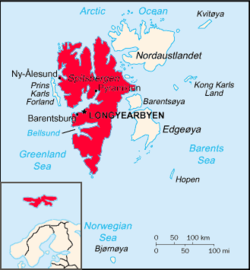- Operation Zitronella
-
Coordinates: 78°54′N 18°01′E / 78.9°N 18.017°E
Operation Zitronella Part of World War II 
Map of Svalbard with Spitsbergen in the west emphasisedDate 8 September 1943[1] Location Spitsbergen, Svalbard, Norway Result German victory[2]
Severe damage to Kapp Linné, Kapp Heer, Barentsburg, Finneset and Longyearbyen[2]Belligerents  Norway
Norway Nazi Germany
Nazi GermanyCommanders and leaders Captain Bredsdorff (POW)[2]
Lieutenant Commander Vigtel †[2]Admiral Friedrich Hüffmeier Strength 152 soldiers
coastal artillery
AA guns[1]2 battleships
9 destroyers
600 soldiers[1]Casualties and losses 11 killed
74 captured[1]9 killed
49 wounded
3 destroyers damaged[1]Operation Zitronella, also known as Operation Sizilien (translates to Sicily) was an eight-hour German raid on Spitzbergen on 8 September 1943.[2]
Contents
Background
During the Second World War, the Svalbard archipelago was the scene of a number of military operations. In August 1941 British, Canadian and Free Norwegian landed on Spitzbergen during Operation Gauntlet. This was aimed to destroy the rich coal mines there together with associated equipment and stores, which (it was correctly assumed) the Germans intended to make use of. No attempt was made to establish a garrison at this time and the civilian population was evacuated. In April 1942 a Norwegian force landed at Barentsburg in Operation Fritham, to establish a permanent presence in the islands, but this operation met considerable difficulties. Nevertheless, by summer of 1943 they were well established.
Meanwhile Germany had established a number of manned meteorological stations in the Atlantic sector of the Arctic, to improve weather forecasts vital for the warfare against Allied convoys from UK to USSR. One of the first manned stations "Knospe" was established in the inner part of Krossfjorden in the main island late 1941 under command of H.R. Knoespel, following the Norwegian and Russian populations had been evacuated in September 1941.[citation needed]
It was decided to evacuate the weather station "Knospe" during the summer 1942, as the ice-free season made an Allied attack possible.The submarine appointed for evacuation of the group of 6 people was U-435 under Kapitänleutnant S. Strelow. The evacuation went according to plan on 23 August 1942, without Allied interference.
Action
In September 1943 it was decided by German Naval Command to attack and destroy the Allied facilities. A naval task force was assembled, comprising the battleships Tirpitz (her only offensive action), Scharnhorst and nine destroyers (five Narvik class destroyers: Z27, Z29, Z30, Z31, Z33, and Erich Steinbrinck, Karl Galster, Theodor Riedel, Hans Lody). On 8 September a battalion of German troops was landed, supported by naval gunfire, seizing the facilities at Barentsburg and forcing the Norwegian garrison to withdraw into the hinterland. After destroying the coal depots and other facilities, the German forces voluntarily withdrew from an untenable position.
Aftermath
Under cover of the attack, the Luftwaffe installed a weather station on Hope Island. At the war's end, the last German troops to surrender were weather teams on Spitzbergen, who gave up in September 1945.[3]
Despite success on the ground, Zitronella/Sizilien was only a qualified success. It brought no lasting benefit; the Allies quickly relieved the men on Spitzbergen and re-established the garrison there. On 19 October the cruiser USS Tuscaloosa arrived at Barentsburg with relief and reinforcements.[4] The operation was dismissed by Morison as a political move, to show Hitler the surface fleet had some value. He suggested the effort was disproportionate to the results and that the same ends could have been achieved more simply.[5]
References
Bibliography
- Samuel Eliot Morison History of United States Naval operations in World War II : Vol X The Atlantic Battle Won, May 1943- May 1945 (1956) ISBN (none)
- Stephen Roskill : The War at Sea 1939-1945 Vol III (1960) ISBN (none)
- Torkildsen, Torbjørn (1998) (in Norwegian). Svalbard : vårt nordligste Norge (3rd ed.). Aschehoug, in cooperation with Det norske svalbardselskap. ISBN 82-03-22224-2 (ib.). http://www.nb.no/utlevering/nb/7265216bde1098edd56c90ec366826fc#&struct=DIVP223.
External links
Categories:- 1943 in Norway
- Battles of World War II involving Germany
- Naval battles of World War II involving Germany
- Battles and operations of World War II involving Norway
- History of Svalbard
Wikimedia Foundation. 2010.
